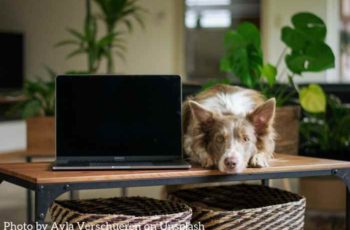Some of the cutest Doodle breed dogs are the Aussiedoodle and the Bernedoodle, with their fluffy coats, friendly nature, and ability to be trained easily. While both have a lot of similar qualities, they also have many differences. If you are planning on buying one of these Doodle pups, making sure that you pick the right pet for your family is important. So what’s the difference between these two?
Both are categorized as herding dogs, however, the Aussiedoodle tends to be more energetic. Aussiedoodles can come in a variety of colors, whereas the Bernadoodle has a distinct tri-color pattern. Also, Bernadoodles are larger than Aussiedoodles and tend to need more grooming than the Aussiedoodle.
There’s a lot more to these two breeds, so we’re going to look at them side by side to help you decide which of these Doodles would be the perfect match for your home.
What Does an Aussiedoodle Look Like?
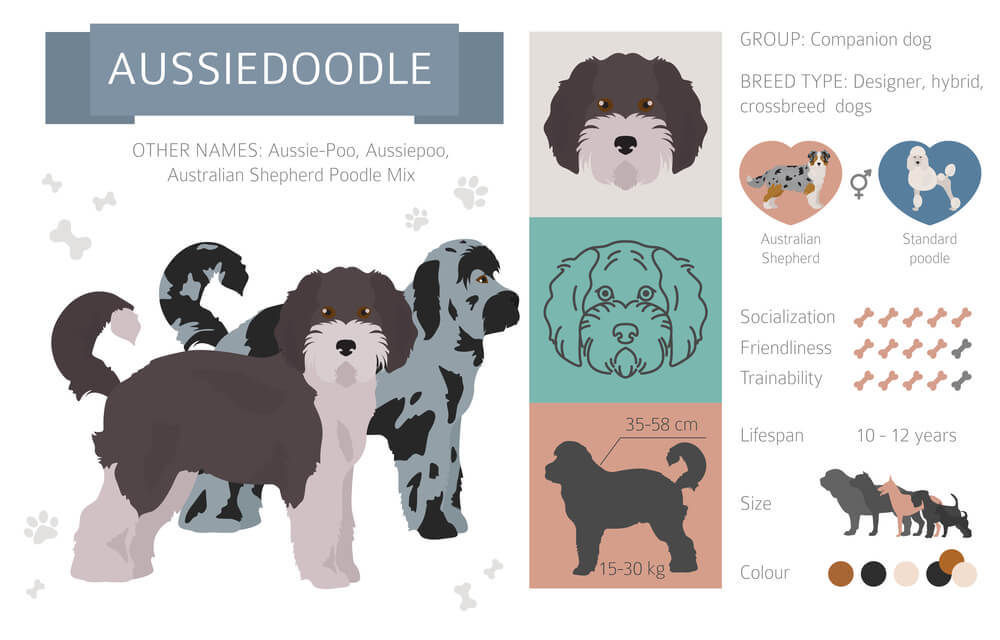
Aussiedoodles have parentage from Poodles and the Australian Shepherd, which means the Aussiedoodle will have traits of both.
They get their intelligence from both parents, high-energy from their Shepherd parent, and a coat that is more hypoallergenic from their Poodle parent. Aussiedoodles are medium-sized with a slim but strong body. They have rounded heads and short muzzles that have big noses, sometimes having a mustache.
Their coat patterns and colors are what sets them apart from a Bernadoodle because Aussiedoodles have the inherited Merle patterning, which can create mottled patches of colors in blue merle, red merle, black and red mixes, black and tan mixes, and sable. Their coats tend to be curly, sometimes with a scruffy appearance to them, but very soft. If you let their hair frow longer, they have a teddy bear appearance. They also have ears that are big and floppy and animated facial expressions.
The average Aussiedoodle can be as tall as 15 or more inches and have a weight range between 40 to 70 pounds. There are also miniature and toy Aussiedoodle, which range between 10 to 15 inches tall and weigh between 10 to 40 pounds.
What Does a Bernedoodle Look Like?
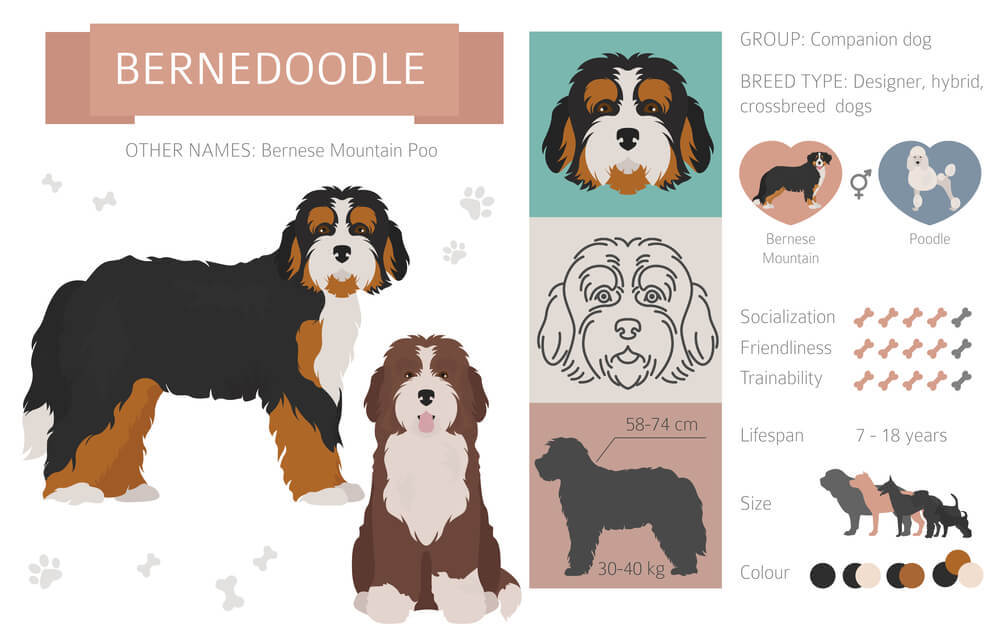
Bernedoodles have parentage from the Poodle and Bernese Mountain dog breeds. They get their curly hair and non-shedding coat from their Poodle parent and the high intelligence that comes from both the Poodle and Bernese Mountain dog.
Their coats can come in a variety of colors but, the most common is a tri-color mix of brown, white, and black. They have big floppy ears, a square body frame, dark oval-shaped eyes, and expressive and sometimes goofy faces. Their muzzles are triangular in shape, their tails are bushy, and the pads of their feet are thickly cushioned. They can be as tall as 29 inches and can weigh up to 80 pounds or more.
You also have the mini and micro versions of Bernadoodles which can average between 12 to 22 inches in height and between 10 to 45 pounds in weight.
What is the Difference between a Bernedoodle and an Aussiedoodle?
As mentioned earlier, Aussie-Poos tend to have a lot more energy than Bernese Mountain Poos do.
Bernadoodles have coats that are tri-colored and Aussiedoodles have that distinctive merle gene in their coats.
A standard Bernadoodle is larger than a standard Aussiedoodle. This is down to the Bernadoodle’s Bernese Mountain dog parent.
The Bernese Mountain dog breed can weigh over 100 pounds. Also, Bernadoodles have coats that tend to grow quicker, which means they need more grooming than an Aussiedoodle. The table below looks at the standard size of both breeds.
|
Header |
||
|---|---|---|
|
Black, Black & White, Brown & Black, Tricolor |
Blue Merle, Red Merle, Black & Red, Black & Tan, Sable |
|
|
Loyal, Goofy, Clever, Gentle, Stubborn |
Playful, Smart, Loyal, |
|
Bernedoodle vs Aussiedoodle: What’s The Difference?
Now that you know the basic differences between the Bernedoodle and the Aussiedoodle, let’s delve a bit deeper into their personalities, history, and health requirements.
History
Bernadoodles were creating using two purebreds, the Poodle and the Bernese Mountain dog.
This hybrid mix cross between the Poodle and Bernese Mountain dog began back in Canada, in 2003. The first litter of Bernadoodles was bred in Ontario by breeder Sherry Rupke. Both of the parent breeds of the Bernedoodle date quite far back, with the Bernese Mountain dog being used in Switzerland as a working breed over 2,000 years ago, and the Poodle dating as far back as the middle ages in Germany.
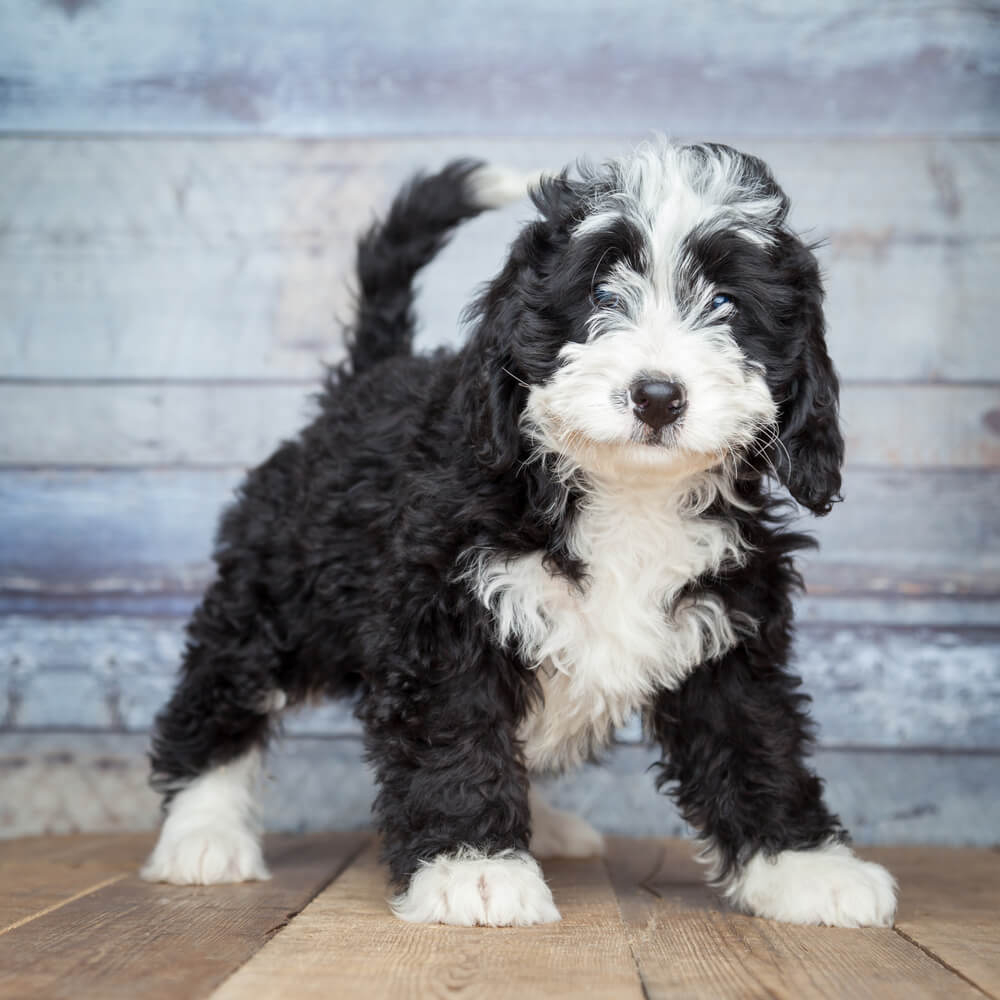
Bernedoodles also go by the name of: Bernese Mountain Poo, Bernesepoo, Bernesedoodle and a Bernepoo.
Aussiedoodles are a fairly new designer dog breed.
It originated with the combining of a Poodle and an Australian Shepherd. How far back this mixed breed was created, however, is still a bit of a mystery. We do know that they became popular over the past 20 or so in the USA.
Temperaments
Bernedoodles have a much calmer temperament than the Aussiedoodle. They love to be around people, making them great companions. They are also gentle, very intelligent, loyal, and sensible. They can be curious and stubborn when it comes to training them, however, socializing and training them early will fix that.
Bernesepoos are very adaptable but are protective and aware of strangers. Because of their somewhat attention-seeking nature, they don’t do well when left on their own for too long and can be susceptible to anxiety disorders as a result.
The Australian Shepherd Poodle Mix has a very loyal and intelligent temperament and is known as being the more active of the two Doodle breeds. Aussiedoodles are pretty easy-going, patient, and devoted to their owners and families. They can be a bit hyperactive though and can get restless at times. Their herding instinct can make them good companions for children. They are smart, which makes them easy to train.
Cost
Aussiedoodle pups can cost anywhere from $700 to $1,200 when bought at a reputable breeder.
Bernadoodles tend to be a bit more expensive, costing from $2,500 to as high as $5,000. The reason they cost more is down to their lineage. Bernese Mountain dogs come from a reputable and great genetic background and can be harder to breed.
Grooming
Bernesedoodles will start to lose their puppy coat at around 9 months old, which means they will need daily brushing to keep their hair from getting matted as the hair sheds.
Aussiedoodles begin losing their puppy coat at around the same time, however, they don’t shed as much and, unlike their Australian Shepherd parent, don’t blow their coats out throughout the year.
A wavier coat often only requires combing once or twice a week, whereas Aussiepoos with a curlier coat need to be groomed more often.
While no dog is 100% hypoallergenic, these two breeds shed less because of their Poodle genetics.
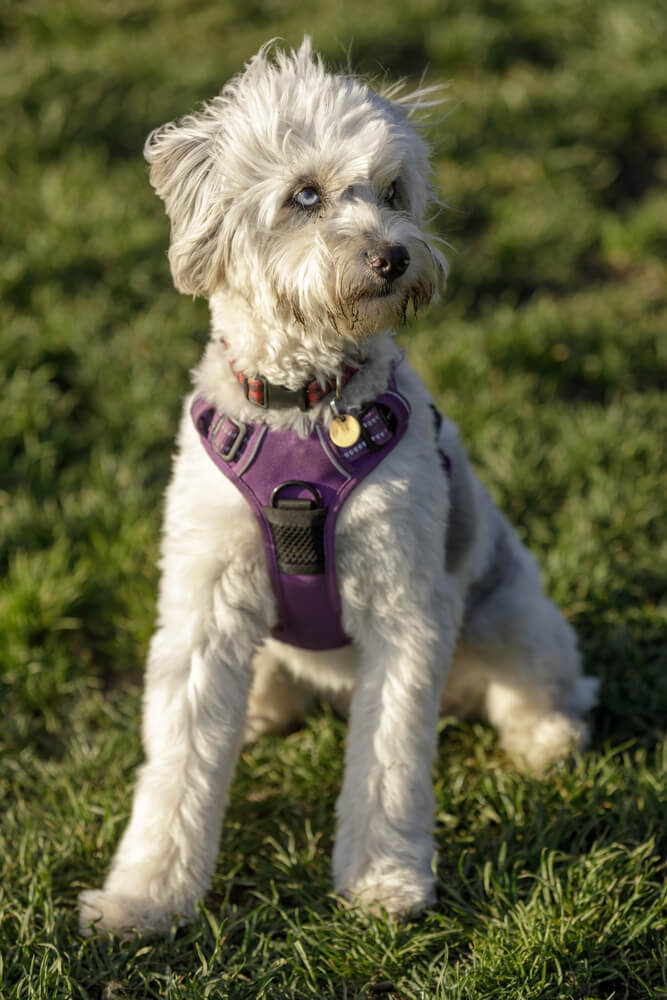
How much grooming an Aussiedoodle requires will vary depending on how curly its coat is.
Both designer breeds have similar types of coats, which can be shaggy, curly, or frizzy.
The longer the hair is, the more difficult it can be to groom them. Both breeds need to have their coats brushed on a regular basis, at least 4 times a week. They will require professional grooming every 6 to 12 weeks, where they should have their hair and nails cut, and be bathed.
Do Aussiedoodles shed? Yes, Aussiedoodles shed, but not very much. This is because they inherit the hypoallergenic, low-shedding genes of their Poodle parent. Coats that are curly or wavy shed less than coats that are straight or long because hairs tend to get trapped in those tight curls, which is why they need regular brushing and grooming (see how to in the video below).
Are Bernedoodles high maintenance? Both dogs are high maintenance because of their curly coats. However, Bernedoodles can be more high maintenance than Aussiedoodle’s if they have coats that are straighter and longer. Both need to be brushed using a slicker or pin brush because their coats can become tangled and matted easily.
Average Lifespan
Both the Aussiedoodle and Bernedoodle are considered to be healthy breeds. Bernadoodles tend to live longer, with an average life span of 12 to 18 years. Aussiedoodles can live between 10 to 12 years.
Trainability
Both breeds are fairly easy to train due to their inherited intelligence.
However, a lot depends on the dog and its personality. Both are eager to please and love to learn new things. Some feel Bernedoodles are a bit harder to train because they can be somewhat stubborn. In truth, both breeds have a bit of a stubborn streak, but for different reasons.
When training an Aussiedoodle, they can become stubborn if they aren’t being challenged enough. They get bored when having to do the same task over and over. Aussiedoodles need variety in their training and both mental and physical stimulation. Bernedoodles, on the other hand, tend to be stubborn during their “teen” months. This is a phase that will pass so more patience is needed when training a Bernedoodle. They tend to respond well to treat-based training.
Barking
Neither of these two breeds are known for barking too much.
Aussiedoodles will bark when they are trying to communicate something to you. Their barking triggers can be for protective reasons, anxiety, and fear, or when they feel separation anxiety from being left alone for too long. They may bark when out for a walk as a means to alert you, but these things can be trained out of them over time.
Bernedoodles are considered to be moderate barkers but will only bark for a reason, much like the Aussiedoodle. Of the two, they are the more vocal. However, this is something that can be corrected with training. Bernedoodles are prone to separation anxiety though, which can lead to barking and destructive behavior if not trained at an early age.
Exercise Needs
Aussiedoodles have a lot of energy, so they will need a lot of exercises to keep them happy. Having a good-sized yard for them to run around in is recommended. They also need to be walked for an hour once a day and playtime throughout the day.
Bernedoodles can have a moderate to high energy level, however, they display this in a different way. They use a gentler approach when they want to play or want your attention. If you have a large Bernedoodle, they will need a backyard to run around in. Bernedoodles also need at least a 30 to 60-minute walk per day. It’s important to use movement-based playtime because, if you leave a Bernedoodle to itself, it can become lazy.
Behavior with Small Children and Other Pets
Bernedoodles will generally do well with other household pets, including cats. They are also very child-friendly dogs. They do get separation anxiety if left alone for too long, so will do better in homes where family members are around a lot. Bernedoodles are also very adaptable to different environments.
Aussiedoodles are child-friendly dogs. When it comes to other pets in the home, they do well with other dogs but sometimes don’t get along with other pets. They will need to be introduced properly early on. They can get separation anxiety if left alone for long periods of time, so will do better if a family member is home during the day.
Health Problems
Bernedoodles are an overall healthy breed, however, there is always the risk of inheriting a medical condition from their parents. They are most at risk for:
The same goes for Aussiedoodle when it comes to inheriting health issues. They are most at risk for:
Using a breeder who does genetic testing on the dogs they are using to mate can help reduce these risks significantly.
Nutrition
Both breeds will require a high-protein diet, especially if they are very active. Food should have a good balance of proteins, fats, carbohydrates, and oils. Portions will depend on the size of the dog. You also need to take your dog’s age into consideration and buy age-appropriate food. Puppies have different nutrition needs than senior dogs.
Bernedoodles require 1 to 8 cups of high-quality dry food a day. This should be split into 2 meals.
Aussiedoodles require 3 to 5 cups of high-quality dry food a day. You can split this into two meals.
Which Is Better: Aussiedoodle or Bernedoodle? ⭐
It’s not really a matter of one being better than the other, but rather which is better for your home, family, activity style. You need to consider the cost of raising them, whether you have other pets and children if you are home a lot or not, and if you live in a large or small home.
Both breeds will need a lot of room for running and playing. Even if you don’t have yard access, they will need a few walks a day and a visit to your local dog park so they can run around and interact with other playmates. When either of these two become bored they have a tendency to chew on things, like furniture, shoes, and clothing.
Both Aussiedoodles and Bernedoodles need different environments to socialize in as well, like being around people they don’t know, going to parks, and taking car rides. It will help more when it comes to training them.
Aussiedoodles are best for those who are looking for a dog that doesn’t shed too much, is intelligent and easy to train, and fits in with an active family lifestyle. They are a good choice if you have allergies to dogs. They also make good therapy dogs because they form close bonds with their owners. You can take them pretty much anywhere, whether it’s hiking, camping, or a day at the office. They make a good choice for first-time owners.
They aren’t the best choice if you have to leave them alone a lot and can develop separation anxiety and are not very adaptable to living in an apartment or small home. They are also known to drool quite a bit.
Bernadoodles are a good choice for homes with other pets and children, however, because of their size and their urge to herd, you need to be careful with them around children who are under 8 years old. They are more laid back and have fewer exercise needs but you do need to make sure that they don’t become lazy. They are great for families who are active or who like to get cozy around the home.
They aren’t to best choice if you are looking for a dog to take to the office with you, if you are not home often, or are a first-time owner because they require more grooming and can be stubborn to train.
Of the two, the Bernedoodle can be the better breed choice because of its adaptability and laid-back temperament. They are known as good family dogs and love to play with everyone, including other pets. While they can sometimes have a stubborn streak, this is something that can be trained out of them as a puppy.


